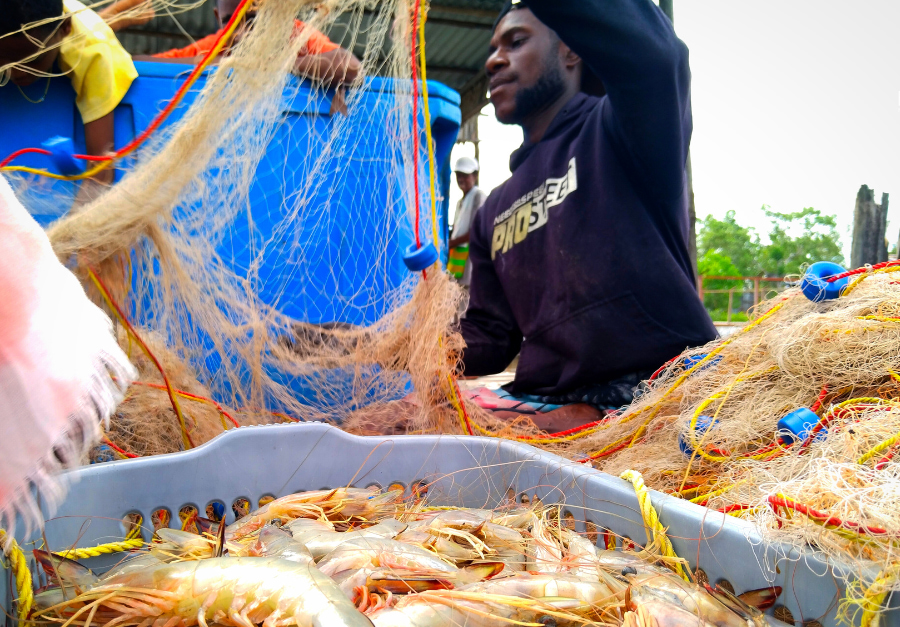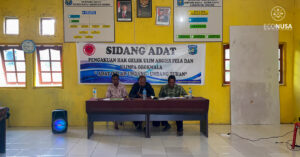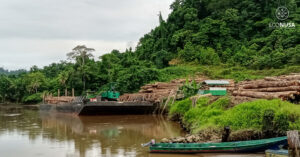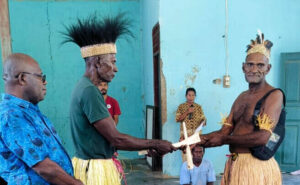
The Inanwatan District in South Sorong Regency, Southwest Papua, is known as one of the regions blessed with abundant fisheries resources. One of the main contributors to this productivity is the expanse of mangrove forests that surround the river estuaries and coastline of Inanwatan.
The mangroves in this area have high productivity thanks to the rich nutrients, calm waters, and sandy–muddy substrate—an ideal environment for various types of marine organisms to thrive. Shrimp, crabs, and fish flourish, making Inanwatan one of the most important fisheries-producing regions in South Sorong.
For the coastal Indigenous communities, mangroves are more than just an ecosystem. They are a source of life. Shrimp and crabs from this area have long served as the community’s key commodities, both for consumption and for sale.
Related Article: Between the Shrimp Summoning Ritual and the Fgan Fen Sisi Cooperative
With more than one major river and mangrove-lined estuary, Inanwatan provides a natural habitat ideal for shrimp, making it the primary livelihood source for most fishing families.
Abundant Resources, Yet Inanwatan Fishers Still Live in Hardship
Despite being endowed with highly productive shrimp habitats, the improvement of fisher welfare in this region remains far behind expectations. During peak seasons, shrimp catches can reach significant quantities. Such economic potential should, in principle, improve community income.
However, reality tells a different story. Fishers face a number of structural challenges that hinder their economic progress.
First, access to capital is nearly nonexistent. Fishers struggle to obtain loans from formal financial institutions to purchase equipment, repair engines, or upgrade their boats. Limited capital forces them to rely on makeshift gear—worn and torn nets and simple boats.
Related Article: Mama Yulita Turns Shrimp Heads Waste into Economic Value Products
Second, the lack of training and assistance in financial management and fish processing limits their ability to expand their enterprises. The community is not yet accustomed to saving, so the income earned today is often spent entirely on the same day.
Third, a long and unfair market chain makes fishers heavily dependent on middlemen from outside the area. Shrimp prices are set very low at the fisher level, while middlemen earn significantly larger profits when selling them to urban markets.
All these challenges reveal a deep gap between the region’s natural potential and the welfare of Inanwatan’s coastal communities.

Boats, Operating Costs, and Fishing Patterns in Inanwatan
Fishing activities in Inanwatan are closely tied to the type of vessels used and the daily operating costs. Fishers typically use three types of boats: non-motorized boats, ketinting boats, and 15 HP outboard motorboats. Most fishers rely on outboard engines because they are faster and allow them to reach fishing grounds more easily.
In Mate Village, there are around 170 fishers, with a small number still using ketinting or non-motorized boats. Meanwhile, Isogo Village has about 190 fishers with a similar distribution of vessels.
Fishing grounds are not restricted by customary boundaries. Fishers commonly operate from the estuary to the cape and reef areas, and even into deeper waters. Reaching these fishing grounds typically takes up to 180 minutes.
Operating costs are relatively high. For each fishing trip, fishers must prepare:
- Fuel: 15–20 liters at Rp10,000–Rp15,000 per liter
- Ice: Rp5,000–Rp10,000
- Other costs: coffee, cigarettes, engine oil
Total daily operating expenses range from Rp200,000 to Rp300,000.
Challenges are compounded by the absence of adequate cold storage on land. Shrimp that are not handled immediately can deteriorate in quality, forcing fishers to sell them at lower prices.
EcoNusa’s Intervention and Assistance: Strengthening Inanwatan Fishers’ Economy
Since January 2025, the EcoNusa Foundation has implemented a range of programs in Inanwatan District to build the capacity of Indigenous fishing communities. These efforts aim to improve the fisheries value chain, expand market access, and strengthen the community’s economic independence.
One of the early breakthroughs was the establishment of the Rumah Timbang (Weighing House), a service post that functions as an economic development center in two sub-groups (Bira and Iwaro). The facility serves as a venue for buying and selling fishery products, storing catches, and distributing them to the KOBUMI warehouse in Sorong.
Related Article: Transforming Shrimp Waste into New Hope
To improve fishing efficiency, EcoNusa also provided training on GPS use, enabling fishers to mark and save potential fishing spots and maximize their catch.
EcoNusa also built a jetty that serves as a labu jolor (landing site) and a production hut for the women’s group (PKK), which processes shrimp heads into shrimp paste. Their product, “SEBATO INANWATAN”, has already obtained a PIRT license and is now regularly marketed to Sorong City. By early October 2025, the women’s group had independently produced 29 kilograms of shrimp paste.
Meanwhile, the women’s association in Isogo Village has also received training on shrimp paste processing and is preparing for routine production.
These initiatives are expected to serve as the first steps toward economic self-reliance for Indigenous fishing communities in Inanwatan—through fairer, more sustainable, and community-beneficial resource management.




